JAVA object oriented programming (oop).ppt
- 1. Introduction Elizabeth MacDonald The State University of New York at Albany
- 2. What we will cover tonight • History of Java • Benefits of Java • Java Environment • Types of Java programs • The Java Platforms • UML • Structured vs. Object Oriented Programming • Basics of a Java application
- 3. The History of Java
- 4. Code-Name Green • The name for Sun’s internal corporate research project aimed at providing intelligent consumer-electronic devices. • Result was Oak – C++ based language – Created by James Gosling – Named after an Oak tree outside his office – Name of new language changed to Java
- 5. Green in the red? • Green project didn’t go far – Marketplace for intelligent consumer- electronic devices was slow to rise – Sun didn’t win certain contracts – Was on the verge of being cancelled
- 6. Saved by the Web! • World Wide Web popularity explosion in 1993 saved project Green • Sun saw the potential for Java providing dynamic content to web pages • Java was formally announced in 1995 • Java is now used for large-scale enterprise applications, applications for consumer devices, and many other purposes.
- 8. “Write once run anywhere” • Platform independent and architecturally neutral • As opposed to C++, you do not need to recompile • This is due to the Java Virtual Machine (we will discuss that in a moment) • Bytecode can be ported across platforms with compatible versions of the JVM
- 9. Rich libraries • The term Java refers to both the language you can use to develop your own libraries, as well as the numerous existing classes that have already been developed. – Simplifies programming – Includes classes for building Graphical User Interfaces, file I/O, networking, web applications, etc.
- 10. Internationalization • Unlike most other languages, Java uses 16 bit Unicode characters – Can represent the phonetic and ideographic character sets of the entire world – C++ uses 8 bits ~ 256 different characters – 16 bit Java char ~ 65,535 different characters
- 11. Distributed • Java classes can execute remotely • Has full support for serialization into bytecode • Has networking capabilities built in – ADTs for distributed message passing
- 12. Security • Java has customizable Security settings • Java applets – Users would be afraid to run applets that could damage their machines – Prevent applets from doing any local file I/O or killing other running processes…
- 13. Threading • Java simplifies multithreading • A thread is a lightweight process • Multiple processes run through the same set of instructions in memory, as opposed to loading the application code into different memory locations • Java has encapsulated threads as an Abstract Data Type
- 14. Object Oriented • Java is a truly Object Oriented programming language • Everything has to reside in a class – Main method and all other methods have to be in a class • Has support for inheritance, polymorphism, message passing, …
- 16. To run a Java Program – Java instructions need to be translated into an intermediate language called bytecode – Then the bytecode is interpreted into a particular machine language
- 17. What is needed… • Compiler: A program that translates a program written in a high-level language into the equivalent machine language. – In the case of Java, this machine language is the bytecode. • Java Virtual Machine (JVM) - hypothetical computer developed to make Java programs machine independent
- 18. Java Virtual Machine • Java programs execute on the JVM. • The JVM is a virtual rather than a physical machine (although the JVM has been implemented in silicon.) • The JVM is typically implemented as a run-time interpreter • Translates Java bytecode instructions native instruction codes
- 19. Processing a Java Program • Source program: Written in a high-level language • Linker: Combines bytecode with other programs provided by the SDK and creates executable code • Loader: transfers executable code into main memory • Interpreter: reads and translates each bytecode instruction into machine language and then executes it
- 21. Java Runtime Environment • The java utility in the SDK provides the JVM as a run-time interpreter. • The JVM provides a run-time environment (JRE) • Enables programs to execute on a host platform. • The Java runtime can work with a security manager to determine which operations a program can perform on the host platform.
- 22. Types of Java Programs
- 23. Program types • Java has four program types, although the differences among them are shallow. • The two most commonly used types are: – Application – Applet
- 24. Java Application • Standalone program in the sense of requiring only the JVM to execute. • Does not require a host program such as a browser. • It’s main method is used as its entry point • Has to have a method with the following signature… public static void main(String args[ ])
- 25. Java Applet • Small program typically downloaded from a server to a client machine. • JVM is built into the web browser • A Web browser acts as the host program for an applet. • An applet is typically launched through an HTML or equivalent document. • They are imbedded into HTML with the <applet> tag
- 26. Java Applet (cont’d) • An applet typically operates under a strict security manager, which imposes sandbox security. • This prevents an applet from performing potentially dangerous operations such as reading from or writing to the local disk. • An applet’s class descends from the standard Applet or JApplet class.
- 28. UML (part 1) • Unified Modeling Language – Meant to facilitate the design, development, deployment and maintenance of software systems. – Standardized in 1997 by the Object Management Group. – Combines methods from Object Modeling Technique (OMT) and Object-Oriented Software Engineering (OOSE). • UML diagrams can serve as high-level design specifications for software systems and, in this role, can guide code development.
- 29. UML (part 2) • Basic UML vocabulary consists of – Things: Entities to be modeled, whether concrete or abstract. – Relationships: Connections among things. – Diagrams: graphical depictions of things and their relationships • We will discuss the types of UML diagrams as they come up.
- 30. Object Oriented vs. Structured Programming
- 31. Structured Approach • Subset of procedural programming • Enforces a logical structure on the program being written to make it more efficient and easier to understand and modify. • Frequently employs a top-down design model – Developers map out the overall program structure into separate subsections. – A defined function or set of similar functions is coded in a separate module or submodule, which means that code can be loaded into memory more efficiently and that modules can be reused in other programs. – After a module has been tested individually, it is then integrated with other modules into the overall program structure.
- 32. Object Oriented Approach • Provides a more natural and intuitive way to view the design process • Modeling software components just as we describe real-world objects – By their attributes, behaviors, and the messages they pass between each other • Objects – Reusable software components – Building blocks
- 33. Benefits of OO • Quality – Small, small-contained manageable objects reduces the complexity of the system development – Less error prone • Productivity – More reuse • Flexibility – Can add or modify objects while minimizing the impact on the rest of the system – This is achieved via encapsulation
- 34. Java and OO • Just because it’s written in Java, does not mean it is object-oriented • The standard Java libraries are not always good examples of OO programming. • Compromise between practical and efficiency considerations and truly good OO design
- 35. What is an object- oriented system? • Has the following 6 properties: – Abstraction with objects – Encapsulated classes – Communication via messages – Object lifetime – Class hierarchies – Polymorphism
- 36. Abstraction • A model of a real-world object or concept • Usually a simplified representation of a complex situation • Designing objects can be difficult • Have to decide on what attributes and behaviors are necessary • Address book example
- 37. Encapsulated Classes • Remember abstract data types? • The process of hiding all the internal details of an object from the outside world. • In Java, this is having definitions for attributes and methods inside a class definition. • State is changed using methods in the class.
- 38. Communication via Messages • Messages are how objects communicate with each other. • Follows client/server model. • Objects can send and receive messages. • Send = invoke a class method • Receive = have your method called by another object • Can also be invoked by the language runtime system or the operating system.
- 39. Class Hierarchies • An ordering of classes. • This includes: – Association – Aggregation – Composition – Inheritance
- 40. Association • A relationship between two classes. • Indicates how the objects of the classes relate to each other. • The relationship has some sort of name (verb). • Multiplicity specifies the number of objects that can participate in the association. Teacher Student teaches learns from * *
- 41. Aggregation • has-a relationship • The aggregate object includes other objects • The included objects are considered to be a part-of the aggregate Car Dealership Car *
- 42. Composition • Special case of aggregation • The whole cannot exist without the aggregate object(s) Car Engine 1
- 43. Inheritance • is-a relationship • A mechanism that allows one class (the subclass) to share the attributes and behaviors of another class (the superclass). • A subclass is a specialization of the generalized superclass. • The derived class may override or provide an alternate definition for an attribute or method of the superclass, or use the default behaviors of the superclass.
- 44. Inheritance Example Animal Warm Blooded Cold Blooded Mammal Bird Flying Non-Flying Parrot Penguin
- 45. More on Inheritance • In Java, all classes are implicitly derived from the Object class, making Object the root class. • Single inheritance is when a class is directly derived from only 1 parent class. • Multiple inheritance is when a class is derived from more than one parent classes. • Unlike other languages, Java does not support multiple inheritance.
- 46. Multiple Inheritance is BAD • Repeated Inheritance – a base can occur more than once in the parents list. • Ambiguity – a feature or method occurs more than once among the parents… which one is called? • This brings us to interfaces, the alternative to multiple inheritance.
- 47. Interfaces • In psychology, a “mask” that allows a person to behave in a manner appropriate to a particular role. • In Java, the specification of methods that a class using the interface must implement, or provide code for. • Defines the is-a relationship between classes. • You will NOT find code in an interface.
- 48. Polymorphism • Dynamic binding of an object to the appropriate method. (The actual binding of a call to a specific method is delayed until runtime.) GoodStudent BadStudent Student +takeExam() : int +takeExam() : int +takeExam() : int
- 49. Basics of a Java Application
- 50. Jumping into Java Programming • To create and run a Java program – Create a text file with a .java extension for the source code. For instance, source code for a first program might reside in the file Hi.java. – Write the source code. – Compile the source code into binary code. – Execute the binary code.
- 51. Compiling • Suppose that the Java source code resides in the plain text file Hi.java. Using the $ as the system prompt, the source code is compiled with the command $ javac Hi.java The javac utility comes with the Java SDK.
- 52. Compiling • Compiling a source file such as Hi.java generates one or more binary files with a .class extension, e.g., Hi.class. – If fatal errors occur during compilation, the process ends with appropriate error messages. – If nonfatal errors occur during compilation, the process continues with appropriate warnings.
- 53. Executing • Once the program has been compiled, it can executed with the java utility. For instance, if the file Hi.class contains a compiled standalone program, the command $ java Hi executes the program.
- 54. Compiling versus executing • Note that the .java extension is included in the compilation but that the .class extension is not included in the execution. Note the contrast: $ javac Hi.java $ java Hi
- 55. A first program (part 1) // This program prints // Hello, world! // to the standard output. class Hi { public static void main( String[ ] a ){ System.out.println( “Hello, world!” ); } }
- 56. A first program (part 2) • The source code for the Hi program resides in a text file with a .java extension, Hi.java. • Every Java program requires at least one source code class, as the Hi example illustrates. • A public class must reside in a .java file of the same name. • There can be at most one public class definition in a file.
- 57. A first program (part 3) • The Hi program is a Java application rather than, for instance, an applet, or a servlet, which are other program types. • A Java application is the most general and basic program type. • An application must have a public static method called main, that takes in an array of Strings: public static void main(String args[]) {}
- 58. A first program (part 4) • The syntax String[] a indicates that a (for “array”) refers to an array. In general, the square brackets indicate an array. In this case, the array can hold references to Strings, which are any command-line arguments passed to the program.
- 59. A first program (part 5) • In the print statement System.out.println( “Hello, world!” ); – System is a standard Java class that represents the system on which the program executes. – out is a static field in the System class and its type is PrintStream, another standard Java class. – println is a PrintStream method.
- 60. A first program (part 6) • In the Hi program’s print statement, the parts System, out, and println are separated by the member operator, the period. • The print statement is terminated by a semicolon. – In Java, the semicolon terminates statements.









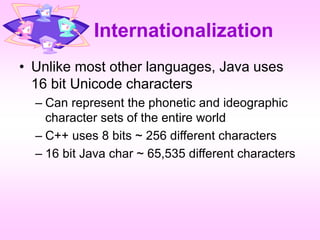





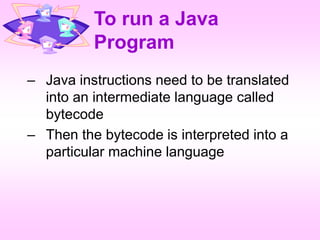




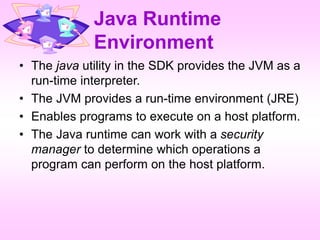


![Java Application
• Standalone program in the sense of
requiring only the JVM to execute.
• Does not require a host program such as a
browser.
• It’s main method is used as its entry point
• Has to have a method with the following
signature…
public static void main(String args[ ])](https://image.slidesharecdn.com/lecture1-240326183115-2b27a632/85/JAVA-object-oriented-programming-oop-ppt-24-320.jpg)








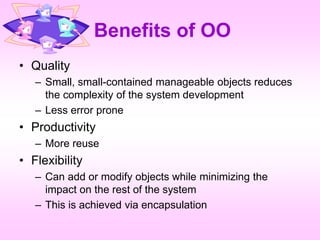



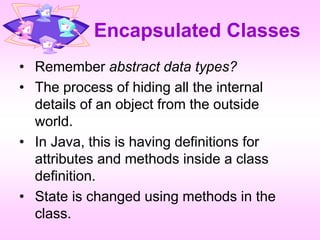

















![A first program (part 1)
// This program prints
// Hello, world!
// to the standard output.
class Hi {
public static void main( String[ ] a ){
System.out.println( “Hello, world!” );
}
}](https://image.slidesharecdn.com/lecture1-240326183115-2b27a632/85/JAVA-object-oriented-programming-oop-ppt-55-320.jpg)

![A first program (part 3)
• The Hi program is a Java application rather
than, for instance, an applet, or a servlet,
which are other program types.
• A Java application is the most general and
basic program type.
• An application must have a public static method
called main, that takes in an array of Strings:
public static void main(String args[]) {}](https://image.slidesharecdn.com/lecture1-240326183115-2b27a632/85/JAVA-object-oriented-programming-oop-ppt-57-320.jpg)
![A first program (part 4)
• The syntax
String[] a
indicates that a (for “array”) refers to an
array. In general, the square brackets
indicate an array. In this case, the array
can hold references to Strings, which
are any command-line arguments passed
to the program.](https://image.slidesharecdn.com/lecture1-240326183115-2b27a632/85/JAVA-object-oriented-programming-oop-ppt-58-320.jpg)

















































